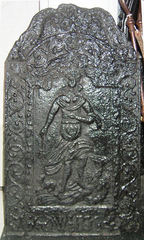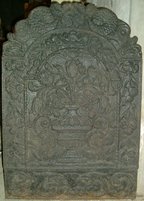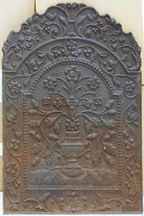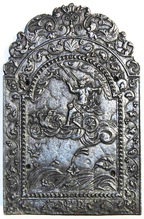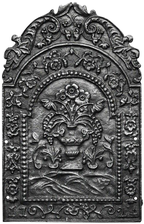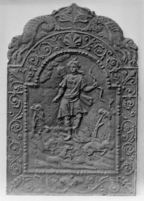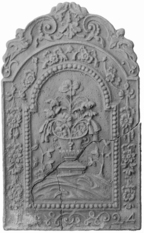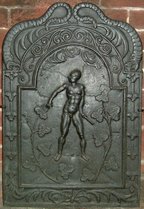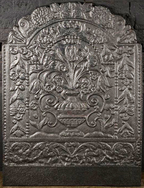-
1005
Description: Arched rectangular central panel within double fillet foliate edging; pictorial scene of a crudely modelled clothed female figure holding a wand? in the right hand; indistinct pictorial element to bottom right; arched rectangular border with fillet edging containing repeated swirled decoration; on top, two mirrored sea monsters.
Notes: A crude pastiche of the 'Dutch' style of fireback; the central figure may be Hera with a peacock. Formerly at the Raleigh Trevelyan estate, St Cadix, Cornwall.
Inscription: WHC[?]
- Decoration tags:
- 'Dutch' (shape)
- fillet (edging)
- whole carved pattern
- pictorial
- mythological
- text
- animals
- humans
Manufactured: in the early 18th century in England.
Current location: Deja Vu Antiques, 31 Fore Street, Lostwithiel, Cornwall, England.
- Attached to series:
- British 'Dutch' style firebacks
- WH series
-
479
Description: Arched rectangular central panel with bead-and-pellet edging; on a ground between two plants, a gadrooned flower vase with two, scrolled handles, tulips and other flowers issuing from the narrow neck; arched rectangular border with fillet edging; mirrored descending flower swags; along a rectangular bottom panel with fillet edging a symmetrical arrangement of swirled foliage; on top, two mirrored sea serpents.
Notes: The presence of tulips suggest a Dutch origin for the pattern of this fireback, although the presence of several examples in England suggest that it was produced here rather than on the Continent.
Copies of this fireback are known.
Manufactured: in the late 17th century in England.
Current location: Maidstone Museum, St Faith's Street, Maidstone, Kent, England.
(part of the Maidstone Museum museum group)
- Attached to series:
- Flower Vase 'Dutch' types
- British 'Dutch' style firebacks
-
1170
Description: Arched rectangular central panel with bead on broad fillet edging; two-handled vase standing on a ground, with flowers and oak fronds issuing therefrom in a symmetrical display; arched rectangular border with fillet edging; symmetrical undulating vine with flowers and leaves descending from a trio of flowers; at the bottom, the letter W in a cartouche between swirled foliage; on top, mirrored swirled foliage issuing upwards from a mythical creature on each shoulder.
Notes: The floral theme and its execution shows parallels with the SHR, N and 1724 series of firebacks and could be from the same workshop. The 'W' initial probably denotes the pattern maker.
Inscription: W
Manufactured: in the late 17th to early 18th century in England.
Current location: not known.
- Attached to series:
- W series
- British 'Dutch' style firebacks
-
1131
Description: Arched rectangular shaped central panel with 'nutshell' edging; pictorial: Mercury in his chariot drawn by two birds (possibly ravens) across the clouds, his caduceus held aloft; above are clouds, below is a landscape with plants; arched rectangular shaped border with fillet edging, a scallop shell top centre with descending symmetrical arrangement of vine and acanthus leaves and tendrils; the monogram, SHR, bottom centre; on top is a symmetrical design of scrolled floral tendrils. One vertical plankline right of centre.
Notes: The design is based on a personification of the planet Mercury in 'Planetarum effectus et eorum in signis zodiaci', by Marten de Vos (1585). The holes were for fixing to a grate.
Inscription: SHR
- Decoration tags:
- 'Dutch' (shape)
- fillet (edging)
- whole carved pattern
- planklines
- pictorial
- allegorical
- monogram
- animals
- humans
- plants
Manufactured: in the late 17th to early 18th century in England.
Current location: not known.
- Attached to series:
- SHR series
- British 'Dutch' style firebacks
- De Vos Planets series
-
53
Description: Arched rectangular shaped central panel, bead on fillet edging, narrow-necked urn with flowers issuing therefrom; arched rectangular shaped border with fillet edging and symmetrical floral swags; on top, stylised fish with floral accessories; at bottom, two looped 'W' figures between split date in bottom corners. A faint plankline, slightly inclined from the vertical and more evident on a later casting, can be seen slightly left of centre.
Notes: The second smallest of six flower vase designs in this series. All incorporate the looped 'W' motif which may be intended to identify the pattern maker. A clear vertical plankline left of centre. Horst Auctioneers, Ephrata, PA, USA, 1 Oct 2022. lot 691 ($400).
Copies of this fireback are known.
Inscription: 17 24
- Decoration tags:
- 'Dutch' (shape)
- fillet (edging)
- whole carved pattern
- planklines
- pictorial
- text
- plants
- objects
Manufactured: in 1724 in England.
Current location: Thornhill Galleries, 43-45 Wellington Crescent, New Malden, Surrey, England.
- Attached to series:
- 1724 series
- British 'Dutch' style firebacks
-
867
Description: Arched rectangular central panel; bead-and-pellet edging; pictorial scene of a male figure, standing on a ground with trees and animals, with a quiver of arrows and holding a bow in his left hand; clouds above; arched rectangular border with fillet edging; repeated, linked scroll-work on all sides; on top symmetrical leaves between two mirrored serpents.
Notes: The figure is probably that of Apollo.
- Decoration tags:
- 'Dutch' (shape)
- fillet (edging)
- whole carved pattern
- mythological
- animals
- humans
- plants
Manufactured: in the early 18th century in England.
Current location: Metropolitan Museum of Art, 1000, Fifth Avenue, New York, New York, United States of America.
Museum number: 08.81.2 (part of the Metropolitan Museum of Art museum group)
- Attached to series:
- British 'Dutch' style firebacks
-
549
Description: Arched rectangular shaped central panel, bead on fillet edging, narrow-necked urn with flowers issuing therefrom; arched rectangular shaped border with fillet edging and symmetrical floral festoons; on top, stylised fish with floral accessories; at bottom, two looped 'W' figures between date split between bottom corners.
Notes: The smallest of six flower vase designs in this series. All incorporate the looped 'W' motif which may be intended to identify the pattern maker.
Copies of this fireback are known.
Inscription: 17 24
Manufactured: in 1724 in England.
Current location: Metropolitan Museum of Art, 1000, Fifth Avenue, New York, New York, United States of America.
Museum number: 08.81.3 (part of the Metropolitan Museum of Art museum group)
- Attached to series:
- 1724 series
- British 'Dutch' style firebacks
-
500
Description: Arched rectangular shaped central panel with astragal and fillet edge, pictorial, a bald, naked man, standing on a mound, holding a baton in his left hand, surrounded by leaf fronds to left and right, and clouds above; arched rectangular shaped border, fillet edging, hanging leaf clusters to left and right, swirled lines above, and draped foliage with monogram at base; on top are two serpents and draped foliage.
Notes: The figure may represent Pheidippides, the messenger between Athens and Sparta during the Battle of Marathon in 490BC.
Copies of this fireback are known.
Inscription: TAN
- Decoration tags:
- 'Dutch' (shape)
- fillet (edging)
- whole carved pattern
- pictorial
- mythological
- monogram
- text
- humans
Manufactured: in the early 18th century probably at Ashburnham Furnace in the Weald area of England.
Current location: West Berkshire Museum, Newbury, Berkshire, England.
Citation: Lloyd, N., 1925, 'Domestic Ironwork I', Architectural Review, 58, pp. 58-67.
- Attached to series:
- TAN series
- British 'Dutch' style firebacks
-
1161
Description: Arched rectangular central panel with bead-and-pellet edging (top and sides); on a ground between two plants, their flowers upstanding, a gadrooned flower vase with two, scrolled handles, tulips and other flowers issuing from the narrow neck; arched rectangular border with fillet edging; mirrored descending flower swags; along a rectangular bottom panel with fillet edging a symmetrical arrangement of swirled foliage; on top, two mirrored sea serpents; at the sides, a narrow vertical extension bordered with a fillet and with bead infill; at the base, a plain extension panel.
Notes: The presence of tulips suggest a Dutch origin for the pattern of this fireback, although the presence of several examples in England suggest that it was produced there rather than on the Continent. One of several very similar designs, varied by the forms of the vases, the style of the flowers and by their dimensions.
Copies of this fireback are known.
- Decoration tags:
- 'Dutch' (shape)
- fillet (edging)
- whole carved pattern
- extension panels
- pictorial
- plants
- objects
Manufactured: in the late 17th century in England.
Current location: not known.
- Attached to series:
- Flower Vase 'Dutch' types
- British 'Dutch' style firebacks
-
509
Description: Arched rectangular central panel with astragal and fillet edging; Phaëton riding Apollo’s chariot across the skies, the sun to the left behind clouds, a lion on ground below, between two trees; arched rectangular border with fillet edging; trailing convolvulus leaves surround the central panel; on top, earl’s coronet above an illegible character, between mirrored, swirled foliage.
Notes: The illustration upon which the design has been based has not been identified, save that it figures in book II of Ovid's Metamorphoses. The convolvulus border is a common feature of this series of firebacks and can be compared with other. The wooden pattern from which this casting was made survives in the collection of the Sussex Archaeological Society (no. 928).
- Decoration tags:
- 'Dutch' (shape)
- fillet (edging)
- whole carved pattern
- planklines
- pictorial
- mythological
- animals
- humans
- objects
Manufactured: in the early 18th century at Ashburnham Furnace in the Weald area of England.
Current location: Penhurst Manor, Penhurst, East Sussex, England.
- Attached to series:
- TAN series
- British 'Dutch' style firebacks
